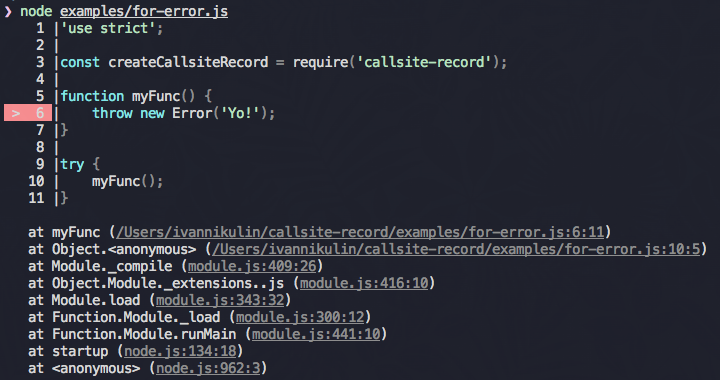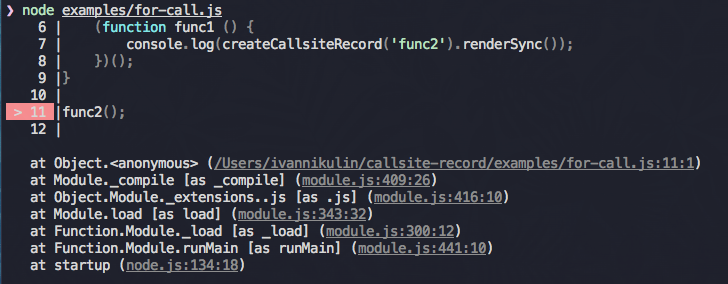Package Exports
- callsite-record
- callsite-record/lib/index.js
This package does not declare an exports field, so the exports above have been automatically detected and optimized by JSPM instead. If any package subpath is missing, it is recommended to post an issue to the original package (callsite-record) to support the "exports" field. If that is not possible, create a JSPM override to customize the exports field for this package.
Readme
callsite-record
Create fancy log entries for errors and function call sites.
For Error:
'use strict';
const createCallsiteRecord = require('callsite-record');
function myFunc() {
throw new Error('Yo!');
}
try {
myFunc();
}
catch(err) {
console.log(createCallsiteRecord({ forError: err }).renderSync());
}
⬇

For function call up in the stack:
'use strict';
const createCallsiteRecord = require('callsite-record');
function func2 () {
(function func1 () {
console.log(createCallsiteRecord({ byFunctionName: 'func2' }).renderSync());
})();
}
func2();⬇

Additional goodies:
- Use renderers for different output formats, e.g. to produce output in HTML.
- Use stack filter to produce clean and beautiful stacks, e.g. removing Node lib internal calls.
Install
npm install callsite-recordAPI
createCallsiteRecord( { forError, isCallsiteFrame, processFrameFn }) → CallsiteRecord
You can generate a callsite for any stack frame, not only the topmost one. Use the isCallsiteFrame function to select
a frame. This function is called for each frame starting from the top. Return true for the desired frame to generate
the callsite.
Example:
const createCallsiteRecord = require('callsite-record');
try {
throw new Error("We're doomed");
}
catch(err) {
const record = createCallsiteRecord({ forError: err });
}createCallsiteRecord({ byFunctionName, typeName, processFrameFn }) → CallsiteRecord
Creates CallsiteRecord for the function up in the call stack specified by byFunctionName. You can optionally specify a
typeName if the function is a method. If the function is a constructor set byFunctionName to constructor.
Example:
const createCallsiteRecord = require('callsite-record');
(function func1() {
(function func2() {
(function func3() {
const record = createCallsiteRecord({ byFunctionName: 'func2' });
})();
})();
})();You can specify processFrameFn function, which will process every frame in callstack. It's usefull when you need to
enable frame processing like source-maps-support.
Example:
const createCallsiteRecord = require('callsite-record');
const wrapCallSite = require('source-map-support').wrapCallSite;
try {
throw new Error("We're doomed");
}
catch(err) {
const record = createCallsiteRecord({ forError: err, processFrameFn: wrapCallSite });
}
(function func1() {
(function func2() {
(function func3() {
const record = createCallsiteRecord({ byFunctionName: 'func2', processFrameFn: wrapCallSite });
})();
})();
})();CallsiteRecord
CallsiteRecord.render([renderOptions]) → Promise<String>
Renders call site record to the string.
Example:
record.render().then(str => console.log(str));CallsiteRecord.renderSync([renderOptions]) → String
Sync version of the CallsiteRecord.render.
renderOptions.frameSize
Specifies the number of lines rendered above and below the call site in the code frame. Default: 5.
Example:
console.log(record.renderSync({ frameSize: 0 }));
// > 12 | func1();
// ...
console.log(record.renderSync({ frameSize: 1 }));
// 11 |(function func2() {
// > 12 | func1();
// 13 |})();
// ...renderOptions.codeFrame
Specifies if code frame should be rendered. If disabled only stack will be rendered. Default: true.
renderOptions.stack
Specifies if stack trace should be rendered in addition to the code frame. Default: true.
renderOptions.stackFilter
Function that will be used to filter stack frames. Function accepts 2 arguments:
stackFrame- stack entry.idx- index of the frame.isV8StackFrame- iftruethenstackFrameis a V8 CallSite object. Otherwise it's a StackFrame object.
Default: null.
Example:
const sep = require('path').sep;
// Remove node core lib calls from the stack trace
record.renderSync({ stackFilter: frame => frame.getFileName().indexOf(sep) > -1 });renderOptions.renderer
Specifies the output format of the rendering. Default: renderers.default. You can pass your own
renderer object (example implementations) or use
one of the built-in renderers:
renderers.default
Provides ANSI-colored output as shown above.
Usage:
const defaultRenderer = require('callsite-record').renderers.default;
record.renderSync({ renderer: defaultRenderer });renderers.noColor
Same as default renderer but without colors.
Usage:
const noColorRenderer = require('callsite-record').renderers.noColor;
record.renderSync({ renderer: noColorRenderer });renderers.html
Outputs HTML that can be later decorated with the CSS and embeded into the web page. Example output.
Usage:
const htmlRenderer = require('callsite-record').renderers.html;
record.renderSync({ renderer: html });Related
- is-es2016-keyword - Determine if string is an ES2016 keyword.
- highlight-es - Highlight ECMAScript syntax for the console or any other medium.